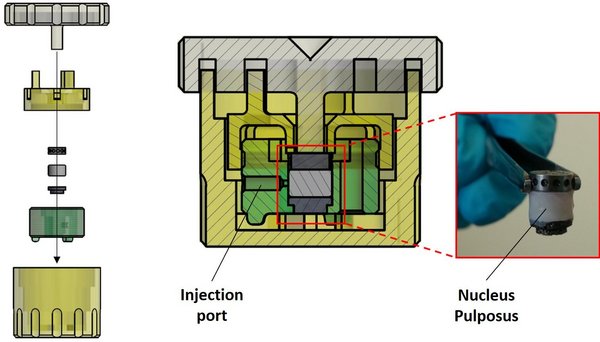
Low back pain is one of the leading causes of disability worldwide with 8 out of 10 people experiencing it at some point in their life. Frequently, degenerated intervertebral discs are the cause for low back pain. Intervertebral discs are large, avascular fibrocartilage layers between vertebrae that allow movements of the spine. A single disc contains the confined nucleus pulposus which is a highly hydrated substance in the center of the disc with a high proteoglycan content. These proteoglycans create a swelling pressure that allows the disc to withstand high compressive forces and maintain its height.
An indication of a beginning disc degeneration is the reduction of proteoglycans in the nucleus pulposus. While late degeneration stages ultimately require surgery, regenerating the nucleus pulposus in earlier stages with injectable biomaterials and cells is a promising new approach to treat disc degeneration. The aim of this project is to develop a loaded ex vivo nucleus pulposus tissue explant culture platform to investigate disc regeneration strategies under physiologically relevant conditions.
To mimic the in vivo situation of the intervertebral disc, an ex vivo nucleus pulposus tissue explant culture system was previously developed. The setup consists of a bioreactor chamber which allows manipulation of the swelling pressure. Additionally, fluids, cells and biomaterials can be injected into the center of the tissue via a port. The tissue will be cultured at low oxygen and glucose levels. Healthy cow-tail discs are used for the culture as they resemble the healthy human disc. However, a disease model of the early degenerated disc is necessary to investigate the proposed regeneration strategies. Therefore, enzymes that cleave proteoglycans will be injected into the healthy tissue. This will create a simulated early degenerated nucleus pulposus tissue with reduced swelling pressure. In the degenerated tissue, the regenerative potential of injectable biomaterials in combination with cells will be investigated and selected for subsequent studies. As the disc is constantly loaded in vivo, a novel compression bioreactor will be developed with which the tissue can be physiologically loaded.